The effect of aquatic training on static and semi-dynamic balance of patients with chronic ischemic stroke: A randomized clinical trial
2 Department of Sport Injuries and Corrective Trainings, Faculty of Literature and Humanity Sciences, Vali-e-Asr University of Rafsanjan, Rafsanjan, Iran
3 Department of Sport Injuries and Corrective Trainings, Faculty of Sport Sciences, Shahid Bahonar University of Kerman, Kerman, Iran
4 Department of Sport Biomechanics, Faculty of Sport Sciences, Shahid Bahonar University of Kerman, Kerman, Iran DOI : 10.5606/tftrd.2020.5437 Objectives: This study aims to investigate the effect of six-week aquatic exercise on the static and semi-dynamic balance of male patients with chronic ischemic stroke (CIS).
Patients and methods: This randomized clinical trial (RCT) included a total of 36 male CIS patients (mean age 60.2±6.7 years; range, 40 to 70 years) between January 2015 and January 2017. The patients were randomly divided into three groups consisting of 12 patients in each group: (i) exercising in shallow water, (ii) exercising in deep water, and (iii) control group. Training sessions were held three days a week for six weeks, and the control group did not participate in these sessions. The balance of the patients was checked using the Biodex balance system in two stages.
Results: There was no significant difference between the two intervention groups (shallow and deep) in terms of the balance assessment post-test (p>0.05), yet there was a statistically significant difference between the two intervention groups (shallow and deep) with the control group in terms of the semi-dynamic balance (total) score, (p<0.05); the semi-dynamic balance (total) of the two intervention groups (shallow and deep) was higher than that of the control group (p<0.05).
Conclusion: Our study results indicate that exercise in both depths is a suitable solution to improve balance, particularly semi-dynamic balance (total) in male CIS patients. Accordingly, aquatic training has a positive effect on balance in male stroke patients and we can prescribe this protocol as a useful remedy for these patients.
Keywords : Aquatic training, chronic ischemic stroke, semi-dynamic balance, static balance

















